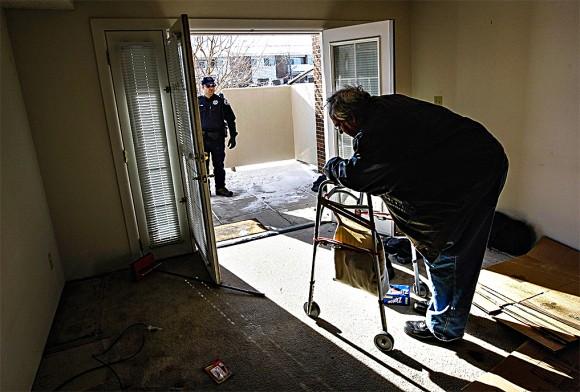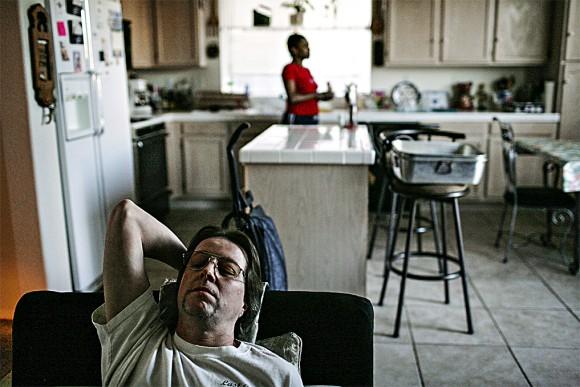What has been called a “quiet catastrophe” has been unfolding in America: the collapse of work for millions of America’s men, and, more recently, for America’s women as well.
Nicholas Eberstadt, the Henry Wendt Chair in political economy at the American Enterprise Institute, estimates there are 10 million men who are jobless and no longer looking for work. According to calculations using 2014 data, an estimated 3.6 million women are in the same situation.
President-elect Donald Trump has announced a raft of policies meant to spur economic growth and create jobs, but thought needs to be given to what specific measures might help this urgent situation.
How to address this crisis depends on what one understands the problem to be. A graph showing the prime-age employment rate for men provides a kind of Rorschach test for possible responses.
Jared Bernstein, senior fellow at the Center on Budget and Policy Priorities, former economic adviser to Vice President Joe Biden, and author of, most recently, “The Reconnection Agenda: Reuniting Growth and Prosperity,” focuses on the cyclical upturns in the jagged line, on those periods of prosperity when workers regain jobs that had been lost.
Eberstadt focuses on the straight trend line, which has been going inexorably and disastrously downward for decades.
Bernstein and Eberstadt represent two typical and contrasting approaches to the unemployment problem.

Bernstein published the graph in a chapter he contributed to Eberstadt’s book “Men Without Work,” in which he critiques Eberstadt’s diagnosis of the employment crisis.
For Bernstein, the key is a missing demand for labor.
“If you look at the employment rate for prime-age workers, they have actually clawed back two-thirds of their losses since the Great Recession,” Bernstein said in an interview. “That doesn’t sound to me like a group that has given up. It sounds to me like a group that is not facing ample opportunity.”
For Eberstadt, the problem is a detachment from work.
Using various government databases, Eberstadt gives a composite portrait of those men who are out of the workforce and not looking for work.
They don’t read newspapers, seem to have few familial responsibilities, and tend not to be involved in a church or their communities. They spend most of their time entertaining themselves with TV or hand-held devices; 31 percent admitted to survey takers that they used illegal drugs.
Bernstein counters this portrait by noting that the causal connection may go from a lack of employment opportunities to suffering from depression, which then leads to these men planting themselves on the couch.
As to the individual motives of the non-working, Bernstein said, “We just don’t know.” His advice to Trump is to aggressively pursue full employment, which involves the federal government using a number of different tools.

Stimulus and Subsidies
Bernstein believes the key to the downward trend his graph shows is the disappearance of manufacturing jobs. He favors trade policies that will reduce America’s chronic trade imbalances, which will create more demand for domestic manufacturing.
Bernstein also favors an infrastructure program, with the caveat that “you have to do it right,” he said.
He would like to see the federal government get involved in communities that “don’t have enough businesses, child care slots, supermarkets, and stores—these are a classic market failure.”
The federal government could subsidize private employers in these neighborhoods, giving them an incentive to move their businesses there.
Bernstein also favors special efforts to help those with a criminal record, and Eberstadt agrees finding ways to help this population is key to addressing the problem of non-working adults. He estimates that, by the end of 2016, there will be 20 million with a felony conviction in their past.

Bernstein supports the Ban the Box initiative, which calls for removing the box on employment applications that must be ticked by anyone with a criminal record.
He also would like to see direct job creation. The federal government would offer a heavily subsidized wage, and at the local level there would be training for specific jobs that would be available in that area.
He would also like to see the federal government fund an apprenticeship program, which would involve recruiting local businesses.
Finally, Bernstein wants to see the federal government get the macro economic policies right to support full employment. This means using monetary policy—primarily interest rates set by the Federal Reserve—and fiscal policy to stimulate the economy. In Bernstein’s view, we took our foot off the pedal of fiscal stimulus too soon—the United States should have carried larger deficits in the years following the Great Recession.

Small Business
Eberstadt said it is “small not big business that employs most Americans.” Over the last eight years, he said, there has been only marginally more small business births compared to small business deaths. A healthy labor market will be one with “many, many new businesses being formed,” he said. Part of the solution? Undo regulatory strangulation and rationalize the tax code.
While Eberstadt agrees that manufacturing jobs are important, he would urge the Trump administration not to “fetishize” manufacturing jobs. The percentage of manufacturing jobs in developed economies around the world has steadily dropped. “Jobs that employ people are good,” Eberstadt said, “whether they have the word manufacturing in them or not.”
In order to protect the manufacturing jobs we do have, Eberstadt urges that we not get into a trade war with China, Mexico, or other countries, saying that trade wars lose jobs, they don’t create jobs.

Because our entitlement programs are administered locally, they tether people to the states in which they are receiving benefits. Finding a way to cut that tie will give people mobility, which will open up more job opportunities.
Eberstadt’s book is meant to initiate “a broad conversation on our ’men without work' problem, a conversation of many voices and differing perspectives.” One important solution is to bring this mostly invisible problem “into the public spotlight.”
Shortcomings in the data we have limit the kinds of conversations we have. The Bureau of Labor Statistics does not count the 13.6 million people who have stopped looking for work as unemployed. When the American public is given an unemployment rate of 4.9 percent, the crisis of the non-working is hidden from them.
The government surveys that are conducted do not reveal the mindsets of those men who are disconnected from work—vital information for anyone who wants to understand this crisis. The Social Security Disability Insurance program does not have an effective audit that would tell us whether it is being used as a substitute for employment insurance.

Stigma
Eberstadt notes that relevant context for the crisis of the non-working is a change in our society’s “mores, and viewpoints, and motivations.”
“Clearly there has been a change in the way most people think about what is decent and appropriate for able-bodied, working-age men to do with their lives in their prime working ages,” Eberstadt said.
Over half of non-working men in their prime years are getting money from at least one government disability program, according to Eberstadt. These funds, Eberstadt writes, finance the non-working’s decision not to work.
He would like to see these programs have a work requirement, as was done 20 years ago with single mothers on welfare. Requiring work stigmatizes non-work and so provides a moral incentive for individuals to move off the couch and back into the workaday world.
Bernstein writes he sees “no good for making these programs less generous or further conditioning them on work.”
Stigma, Eberstadt said, “is often a kinder and gentler way of achieving social objectives than police power.”






Friends Read Free